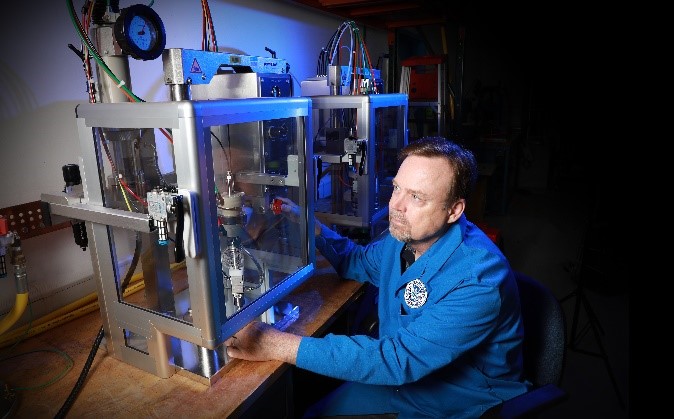
As the Transportation Security Administration (TSA) screens nearly two million people each day, officers are faced with the challenge of finding even the smallest sign of a threat. Microscopic particles of explosives can cling to a nefarious actor despite their best intentions to conceal any evidence of hidden contraband on their person or in their bags.
To confirm threats at checkpoints, Transportation Security Officers rely on the accuracy of explosives trace detectors (ETD) to detect these tiny clues and ensure the safety of the public. As such, operational components like TSA and U.S. Secret Service (USSS) look to the Science and Technology Directorate (S&T) Transportation Security Laboratory (TSL) to test, check, and validate their equipment regularly. To keep pace with ever changing threats, TSL continuously searches for more efficient and effective methods to keep machines performing to their full capability and to empower front line operators to trust their equipment.
When confirming if contraband is present at a check point, screening officers collect traces of contamination from different surfaces (such as luggage, purses, or clothing) using a special swab, which they insert into an ETD for analysis. However, before the equipment is ready for use in prime time, officers must confirm its calibration to accurately identify threat substances. Recently, TSL Chemist Dr. Jim Deline developed a novel method to more efficiently test their equipment.
Improving Test Methods
Known among DHS components for their rigorous testing methods using minute quantities of real contraband, TSL is a forward leaning laboratory that continuously finds and improves testing methods. This is one of TSL’s many areas of expertise.
The science behind Deline’s device resembles that of an asthma inhaler which, like ETD machines, requires fixed measurements of the materials being deposited. Deline’s method could replace the previous “dry transfer” method.
“The dry transfer technique works but is very time consuming and uses a lot of consumables. I realized I could use asthma inhaler technology to change the way we validate ETDs,” said Deline, who recently filed a patent application for his idea.
What sets Deline’s method apart from the dry transfer method is that it reduces the amount of time needed to prepare test samples, while still ensuring a fixed amount of contraband is deposited each time the materials are tested. It can be used on a variety of different surfaces that may be tested at a TSA checkpoint, including leather, vinyl, metal, or cardboard. This new method also reduces the need for supplies to transfer test substances, as it turns the test substance into a gas before it comes into contact with a test surface, or substrate.
“This rapid vaporization would prevent its interaction with the substrates, so the explosive could be deposited directly onto the substrates, obviating the dry transfer step,” Deline said. He coined the term “just in time test samples” because they can be prepared as-needed. And when working in a fast-paced environment, time is of the essence for officers who need to quickly check their equipment.
Broadening the Application
While S&T and TSA are very interested in the new process, so was the USSS. Their agents needed something that could more accurately confirm the presence of a broader range of explosive compounds. As threats evolve and perpetrators use a more diverse set of explosives, TSL is vigilant in updating and deploying new methods.
During the past year, Deline and his team have been maturing the device so that it can produce those “just in time test samples.” They conducted stability and detection studies on explosives dissolved in three different solvents to select the most stable solutions that can last at least six months when stored at room temperature. “The test kits can be used to verify that the ETDs can correctly alarm in the field on nine different explosives,” explained Dr. Deline.
TSL recently transitioned Deline’s device to TSA and USSS to be used in operational environments. On May 28, Deline delivered three professional quality test kits to the Secret Service and TSA’s Transportation Security Integration Facility in Washington, D C.

